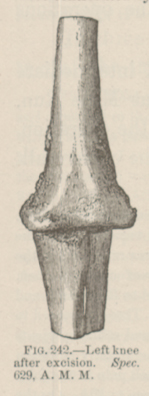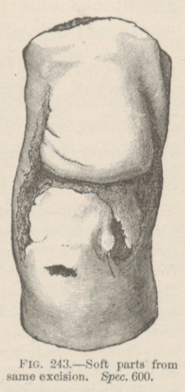Title: Gould, Charles F.
Source text: The Medical and Surgical History of the War of the Rebellion. (1861-65.), Part 3, Volume 2 (Washington, DC: Government Printing Office, 1883), 392.
Civil War Washington ID: med.d2e16453
TEI/XML: med.d2e16453.xml
CASE 618.—Private Charles F. Gould, Co. I, 1st Pennsylvania Reserves, was wounded at the second battle of Bull Run, August 30, 1862. A musket ball appeared to have entered the outer side of the joint near the head of the tibia. The patient was sent to Fairfax Seminary Hospital, near Alexandria, September 9, 1862. On September 15th, an excision of the knee joint was performed. The condyles of the femur, the patella, and the heads of the tibia and fibula were removed through an H-shaped incision. The wound united, and there seemed every prospect of a satisfactory result, when, on October 8th, symptoms of pyæmia were developed, and death ensued October 12, 1862. The pathological preparation was forwarded to the Army Medical Museum by Acting Assistant Surgeon T. O. Bannister. The specimen represented in the left-hand wood-cut (FIG. 242) shows the osseous portion, while the appearance of the soft parts are shown in the right-hand wood-cut (FIG. 243). (See Cat. Surg. Sect., 1866, pp. 336, 500.)²
² Circular No. 6, War Department, S. G. O., Washington, 1865, p. 60; CULBERTSON (H.), Excision of the Larger Joints of the Extremities. Prize Essay, in Trans. Am. Ned. Assoc., 1876, p. 182, Case 8.

